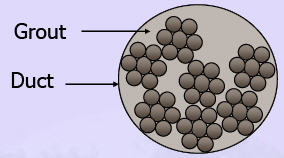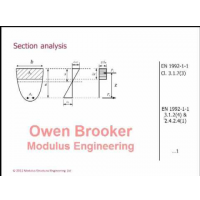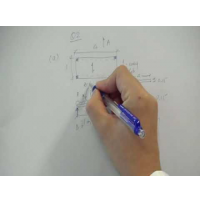Prestressing steel
Pre-stressing raises both the quality and the resistance to tension and compression characteristics of the steel; the technique actually manages to create a state of co-action in which the tensions and deformations are opposed to those induced by the loads which will subsequently act upon the structure. It also raises the resistance to tension of reinforced concrete which is, in fact, negligible.
The development of pre-stressed concrete was influenced by the invention of high strength steel. It is an alloy of iron, carbon, manganese and optional materials. In addition to pre-stressing steel, conventional non-pre-stressed reinforcement is used for flexural capacity (optional), shear capacity, temperature and shrinkage requirements. Wires. A pre-stressing wire is a single unit made of steel. The nominal diameters of the wires are 2.5, 3.0, 4.0, 5.0, 7.0 and 8.0 mm. The different types of wires are as follows: Strands. A few wires are spun together in a helical form to form a pre-stressing strand. The different types of strands are as follows: Tendons. A group of strands or wires are placed together to form a pre-stressing tendon. The tendons are used in post-tensioned members. The following figure shows the cross section of a typical tendon. The strands are placed in a duct which may be filled with grout after the post-tensioning operation is completed . Cables. A group of tendons form a pre-stressing cable. The cables are used in bridges. Bars. A tendon can be made up of a single steel bar. The diameter of a bar is much larger than that of a wire. Bars are available in the following sizes: 10, 12, 16, 20, 22, 25, 28 and 32 mm. The steel is treated to achieve the desired properties. The following are the treatment processes: The steel in pre-stressed applications has to be of good quality. It requires the following attributes: The tensile strength of pre-stressing steel is given in terms of the characteristic tensile strength (fpk). The characteristic strength is defined as the ultimate tensile strength of the coupon specimens below which not more than 5% of the test results are expected to fall.Forms of Pre-stressing Steel
1) Plain wire: No indentations on the surface.
2) Indented wire: There are circular or elliptical indentations on the surface.
1) Two-wire strand: Two wires are spun together to form the strand.
2) Three-wire strand: Three wires are spun together to form the strand.
3) Seven-wire strand: In this type of strand, six wires are spun around a central wire. The central wire is larger than the other wires.
Types of Pre-stressing Steel
Properties of Pre-stressing Steel
1) High strength
2) Adequate ductility
3) Bendability, which is required at the harping points and near the anchorage
4) High bond, required for pre-tensioned members
5) Low relaxation to reduce losses
6) Minimum corrosion.

